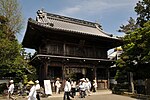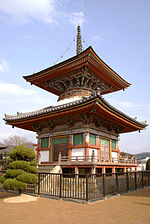kami. Unlike a jingū-ji, a miyadera had no priestly clan performing kami rituals in a separate shrine. Also, unlike those of a jingū-ji, monks at a miyadera...
14 KB (1,739 words) - 15:00, 4 August 2024
Kōfuku-ji (興福寺, Kōfuku-ji) is a Buddhist temple that was once one of the powerful Seven Great Temples in the city of Nara, Japan. The temple is the national...
13 KB (934 words) - 05:47, 18 December 2024
case of the Ise Jingū and the Meiji Jingū. The name Jingū alone, can refer only to the Ise Jingū, whose official name is just "Jingū". It is a formulation...
82 KB (9,505 words) - 08:54, 11 November 2024
Indonesian Archipelago Chaitya, a Buddhist shrine that includes a stupa Jingū-ji, a religious complex in pre-Meiji Japan comprising a Buddhist temple and...
15 KB (1,591 words) - 16:16, 1 December 2024
site of nature worship. Seiganto-ji, part of the Kumano Sanzan shrine complex, is one of the few remaining jingū-ji or shrine temples following the forcible...
8 KB (893 words) - 00:48, 27 March 2024
believed to be the first shrine-temple (jingū-ji) ever. The resulting mixed complex, called Usa Hachimangu-ji (宇佐八幡宮寺, Usa Hachiman Shrine Temple), lasted...
17 KB (1,643 words) - 12:34, 23 November 2024
was made in the 8th century during the Nara period founding so-called jingū-ji (神宮寺), that is shrine-temples, complexes comprising both a shrine and a...
24 KB (2,855 words) - 20:23, 10 October 2024
Gakuen-ji (鰐淵寺) is a Buddhist temple located in the Besshō neighborhood of the city of Izumo, Shimane Prefecture, Japan. The temple's full name is Uryōzan...
7 KB (781 words) - 11:00, 22 November 2024
Ryōzen-ji (Japanese: 霊山寺, lit. 'Vulture Peak Temple') is a Shingon Buddhist temple in Naruto, Tokushima Prefecture, Japan best known as the first temple...
4 KB (248 words) - 12:26, 19 May 2024
Gokoku-ji (護国寺, "Protection of the Nation Temple") is a Zen Buddhist temple in Naha, Okinawa. Established in 1367, the temple served as a major national...
7 KB (853 words) - 09:23, 8 August 2024
Sagami-ji (酒見寺, or Sagami-dera), is a Shingon Buddhist temple in Kasai, Hyōgo Prefecture, Japan. Its mountain name (sangō) is Senjōsan (泉生山). Emperor Shōmu...
3 KB (213 words) - 02:14, 28 June 2024
transformed into an origin legend of Daigorin-ji (大御輪寺, also Ōmiwa-dera), the Buddhist temple (jingū-ji) associated with Ōmiwa Shrine during the medieval...
29 KB (3,203 words) - 05:37, 19 December 2024
Hachiman (section Empress Jingū)
by birth who reigned in the 3rd–4th century and the son of Empress Jingū (神功皇后, Jingū-kōgō), later became deified and identified by legend as "Yahata-no-kami"...
17 KB (2,068 words) - 04:10, 13 November 2024
Rokugōmanzan temples were under the control of Miroku-ji, a Hossō sect temple that was the Jingū-ji of Usa Jingū. In the late Heian period, these temples switched...
6 KB (607 words) - 04:59, 21 June 2024
Buddhist sub-temples. If a shrine housed a Buddhist temple, it was called a jingū-ji (神宮寺, lit. shrine temple). Analogously, temples all over Japan used to...
50 KB (5,730 words) - 00:55, 20 September 2024
the former Mirokuji, a Buddhist temple once connected to the shrine as a jingū-ji. Usuki Stone Buddhas: Approximately 60 cliff carvings of Buddha that were...
51 KB (5,432 words) - 13:13, 22 November 2024
Zuiryū-ji (瑞龍寺) is a Buddhist temple of the Rinzai sect built in Mino Province (modern-day Gifu, Gifu Prefecture, Japan). It is a branch temple of Myōshin-ji...
3 KB (137 words) - 23:22, 13 December 2024
Hikosan Jingū, was open in 2005. Mount Hiko Shugendō List of Shinto shrines Wikimedia Commons has media related to Hikosan Jingū. Hikosan-jingu Shrine...
4 KB (313 words) - 06:34, 27 January 2024
Buddhist sub-temples. If a shrine housed a Buddhist temple, it was called a jingū-ji (神宮寺, lit. shrine temple). Analogously, temples all over Japan used to...
20 KB (2,225 words) - 20:08, 20 December 2024
called a jingū-ji (神宮寺). In addition, when it is a Buddhist temple functioning as the guardian of an establishment, it was called a chinju-ji (鎮守寺), chinju-dō...
6 KB (646 words) - 18:21, 24 December 2024
of jingū-ji, or "mixed shrine-temple complex" with the former Miroku-ji (弥勒寺) having been built on the grounds of Usa Jingū to form Usa Hachimangu-ji (宇佐八幡宮寺)...
7 KB (693 words) - 14:14, 21 December 2024
reside in devaloka and thought to be seeking liberation just like humans. Jingū-ji were built within shrines as locations where Buddhist practices could occur...
142 KB (20,318 words) - 04:20, 25 December 2024
Iwashimizu Hachimangū (category Shrines dedicated to Empress Jingū)
1868 Iwashimizu was actually a shrine-temple complex (jingū-ji) called Iwashimizu Hachimangū-ji (石清水八幡宮寺) dedicated to Buddhism as much as to kami worship...
9 KB (833 words) - 03:28, 16 July 2024
responsible for festivals. Jingū (神宮, lit. 'Divine Palace/Shrine') – A shrine enshrining a member of the Imperial family, like Meiji Jingū, which enshrines the...
122 KB (14,029 words) - 14:23, 23 December 2024
originated from the influences of nearby Usa Jingū, the head shrine of Hachiman shrines in Japan. Usa Jingū, which is located in Usa at the base of the...
9 KB (826 words) - 01:04, 31 July 2024
Tsurugaoka Hachimangū (category Shrines dedicated to Empress Jingū)
Buddhism and kami worship in shrine-temple complexes like Tsurugaoka called jingū-ji had been normal for centuries until the Meiji government decided, for political...
22 KB (2,316 words) - 21:46, 8 December 2024
Byōdōji and Ōgorinji (Ōmiwadera), temples serving as the "parish temples" (jingū-ji) of Ōmiwa Shrine in Nara Prefecture. Mononobe Shintō Based on the text...
21 KB (2,770 words) - 06:31, 17 November 2024
749. Kami enshrined here include Emperor Ojin, Emperor Nintoku, Empress Jingū and Emperor Chūai in addition to Hachiman. Hachiman shrine List of National...
1 KB (64 words) - 02:15, 28 June 2024
the Nara period (710–794) with the founding of so-called shrine-temples (jingū-ji), complexes consisting of a shrine dedicated to some kami and of a Buddhist...
10 KB (1,175 words) - 19:00, 20 December 2024
that the Inari Shingyō was first compiled at Aizen-ji, a branch temple of the Shingon Tō-ji and jingū-ji of Fushimi Inari-taisha, by the head priest Tenna...
4 KB (187 words) - 12:02, 25 February 2024
























